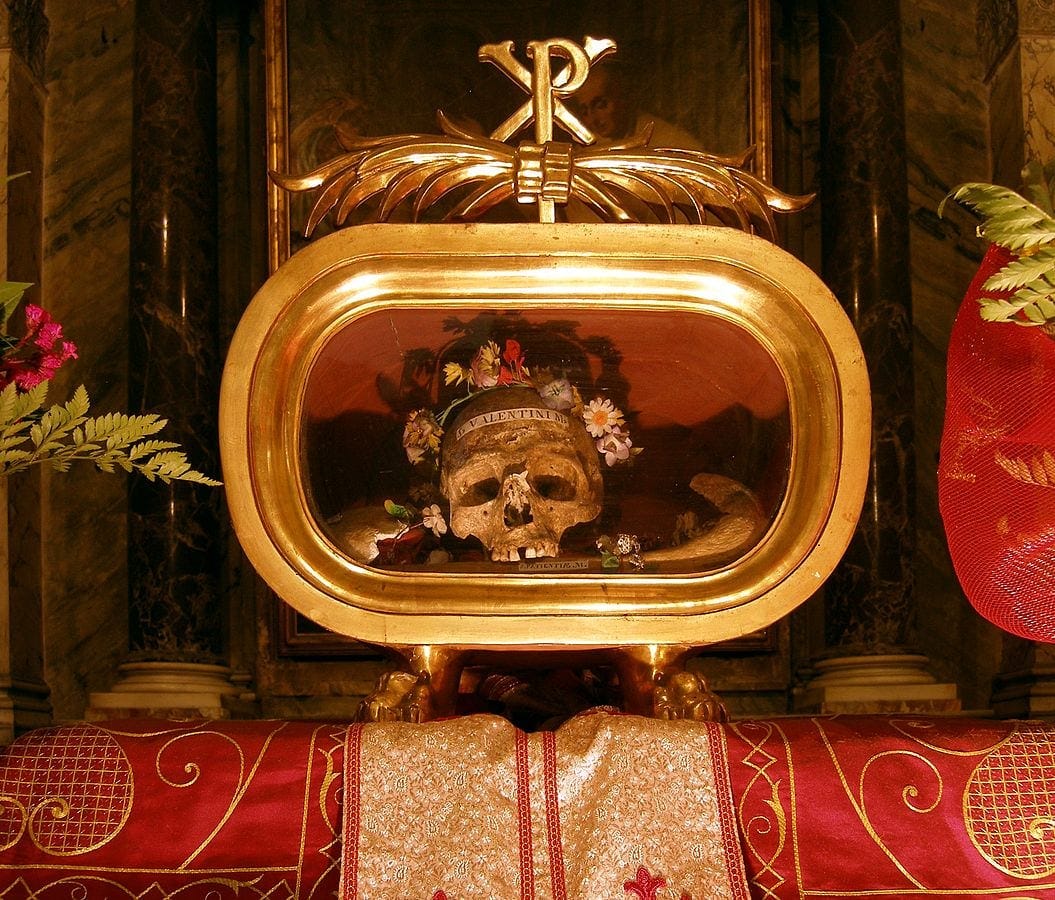
Before forgetting Valentine’s Day again.
I had thought about writing this piece on love when my algorithms reminded me it was Valentine’s Day. I decided to go ahead anyway. Knowing by now that I try to hide my sentimentality, the bots were helpful. Links to articles like “The Real Truth About Valentine’s Day” exceeded reminders of Trump’s grotesqueries.
You may already know the story—sad no doubt by today’s standards, festive in its origin: Valentine’s Day began as an ancient Roman festival. It combined purification rites with fertility ceremonies and included elements that were religious and sexually symbolic. Naked young men were prepared for action and drew women’s names in a matchmaking lottery. The women were beaten with the hides of the goats and dogs they had killed, hopefully making them fertile. Couples would couple up for the festival’s duration and switch partners if the experience wasn’t satisfying.
The Church adjusted the excess. Our celebration began as a Christian feast day established by the Pope in the late 5th century. Romantic associations emerged in medieval times through poets like Chaucer. There had been several Valentines, all martyred, one of them beheaded (photo above) and declared a saint. He wrote the first “valentine” greeting to a young girl he tutored and fell in love with. Perhaps without knowing it, the Church ended up canonizing courtly love, backhanding later competition. Holy stratagems can be good at disarming “pagan” rivals.
Once looked down upon, romance outside marriage became normal. Marriage was a contract, affection was not necessary. Courtly love was a glorious affair. The happiest Valentine was not a wife but the other woman, married or not. There was a catch; this time, there was no. . . coupling. “Courtly love” was usually unconsummated physically and, thus, all the more intense—true to the nature of desire today. Passion had to be unfulfilled to be desirable.
Denis de Rougemont traces the conflict between passion and marriage in his classic, Love in the Western World. Romantic love in Western culture usually requires some form of impossibility or doom to reach its highest expression. Consider the novels that suggest as much—for example, Madame Bovary, Anna Karenina, and The Great Gatsby. With Tolstoy, if Anna were simply content in her marriage to Karenin, or if Levin immediately found fulfillment, who would want to put up with all the Russian names?
Contrary to Valentine’s wishful thinking today, lovers experience the most profound romance precisely when they cannot fulfill it—whether social barriers, tragic timing, or death stand in their way. Romantic frustration became a transcendent achievement: the inability to possess what we desire makes that desire more pure and meaningful, at least more alluring. (A more august voice from medieval times, the mystic Meister Eckhart, sounds almost like a postmodern philosopher: “Only the hand that erases can write the true thing.”)
Whatever the Scriptures teach, or morals command, a faithful marriage is a triumph over history. The result is a persistent undercurrent of dissatisfaction in romantic life.
In previous generations, love was a social obligation, not just an individual experience. Today, we marry for love (for the most part), usually as a personal choice. While this romantic ideal is appealing, it has spawned a decline in marital stability; family security is fragile. By contrast, contractual marriages were not as miserable as counterparts that make the news today.
Aware of this history, Stephen Mitchell concluded that earlier understanding of desire could be employed to good advantage. An eminent psychoanalyst and renowned marriage counselor, he would have agreed with Kierkegaard that boredom accounts for a lot of evil. He was less concerned about preventing divorce and extramarital affairs than with making them unnecessary. Couples can be much more passionate even though married. It helps to become less predictable. What you don’t know about your partner can make them more attractive and sometimes mysterious. Resolving conflict matters less than practicing more effective arguments. “Love isn’t dangerous anymore—not because it can’t be, but because we won’t let it.” No wonder we get bored.
Mitchell’s insights about passion and predictability extend beyond personal relationships to political life. The political sociologist Max Weber did so. From the days of courtly love to our own, attitudes toward passion, marriage, and romance have both reflected and shaped our understanding of politics and leadership. Weber described charisma as a revolutionary force that disrupts established order and routine. Charismatic authority represents a distinct style of leadership particularly appealing in politics and social movements.
We bemoan a cult of personality, throwing out the baby with the bathwater. Unless integrity is desirable and not just what is right, something more interesting will take its place—recalling Billy Joel’s song “Only the Good Die Young”: “I’d rather laugh with the sinners than cry with the saints.”
Right now, the new president(s) laugh and have a good time, bringing to mind the festival before Valentine’s Day: brutality was expected, the bloodier, the better; the law was differently binding, and cruelty was just “coupling.” The crowds settled for nothing less.
In time, passion became more civilized. Perhaps too civilized. Truer love is more dangerous—and desirable. John Lewis said it well: “Embrace good trouble, necessary trouble, and help redeem the soul of America.”
A little late: Happy Valentine’s Day, after all.
Notes and reading
History of Valentine’s Day – History.com Editors (updated February 4, 2025). Including how Cupid became the mascot of Valentine’s Day.
Love in the Western World – Denis de Rougemont (1983). “Literary high adventure pursued with unflagging energy and assurance.” – John Updike.
Can Love Last? The Fate of Romance Over Time – Stephen A. Mitchell (2002). Mitchell jolts and jumpstarts the reader in ways that mirror the psychological disequilibrium at the heart of lasting romantic love.
Life Against Death: The Psychoanalytical Meaning of History with an introduction by Christopher Lasch – Norman O. Brown (1959). Classical scholar and social philosopher Brown argues that the future of humanity depends on the resurrection of the body. Susan Sontag calls Brown’s book “the first major attempt to formulate an eschatology of immanence since Nietzsche. It cannot fail to shock if taken personally.”
Holy stratagems. . . secular rivals. – Because of historical uncertainty, not morals, the Church revised its universal calendar in 1969, removing some feast days, including St. Valentine’s. Churches can still celebrate his feast day.
Meister Eckhart – “Only the hand that erases can write the true thing.” – The epigraph to former U.N. Secretary-General Dag Hammarskjöld’s Markings.
Love and Politics – Eszter Kováts, editor, (Friedrich-Ebert-Stiftung Budapest, 2015 – online). Edited lectures, including on courtly love and current concepts of dominance, initiative, subordination, dependence, and partnership. Kováts is a research fellow at the Institute of Political Science at the University of Vienna. Her areas of research: anti-gender politics, illiberal Right, illiberal Left.
Charisma – Weber discusses “charisma” most extensively—its nature, routinization, and role in social change—in Economy and Society (2019), chapter 3 “Types of Rule.”
Victorian‑Era “Vinegar” Valentines Could Be Mean and Hostile – Crystal Ponti, a freelance writer, published in good venues. Find her at @HistoriumU. – History.com (February 10, 2020). Sample: “To My Valentine / ‘Tis a lemon that I hand you and bid you now ‘skidoo,’ Because I love another—there is no chance for you.”
Tip-Off #181 – Doing enough?
About 2 + 2 = 5




